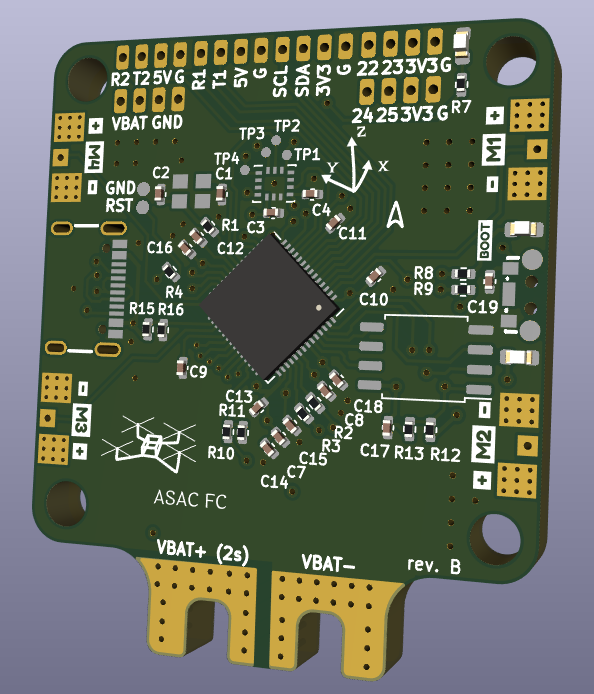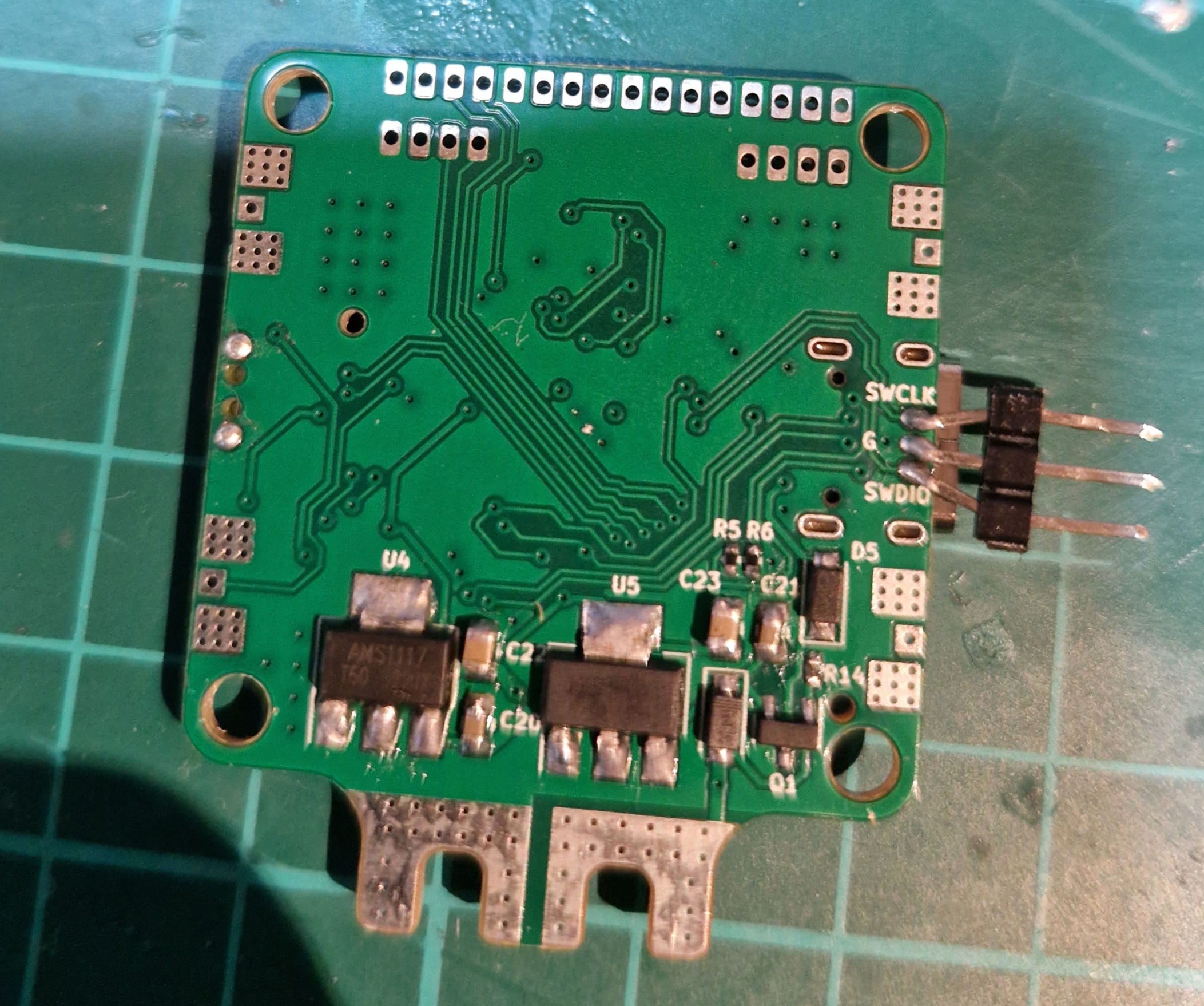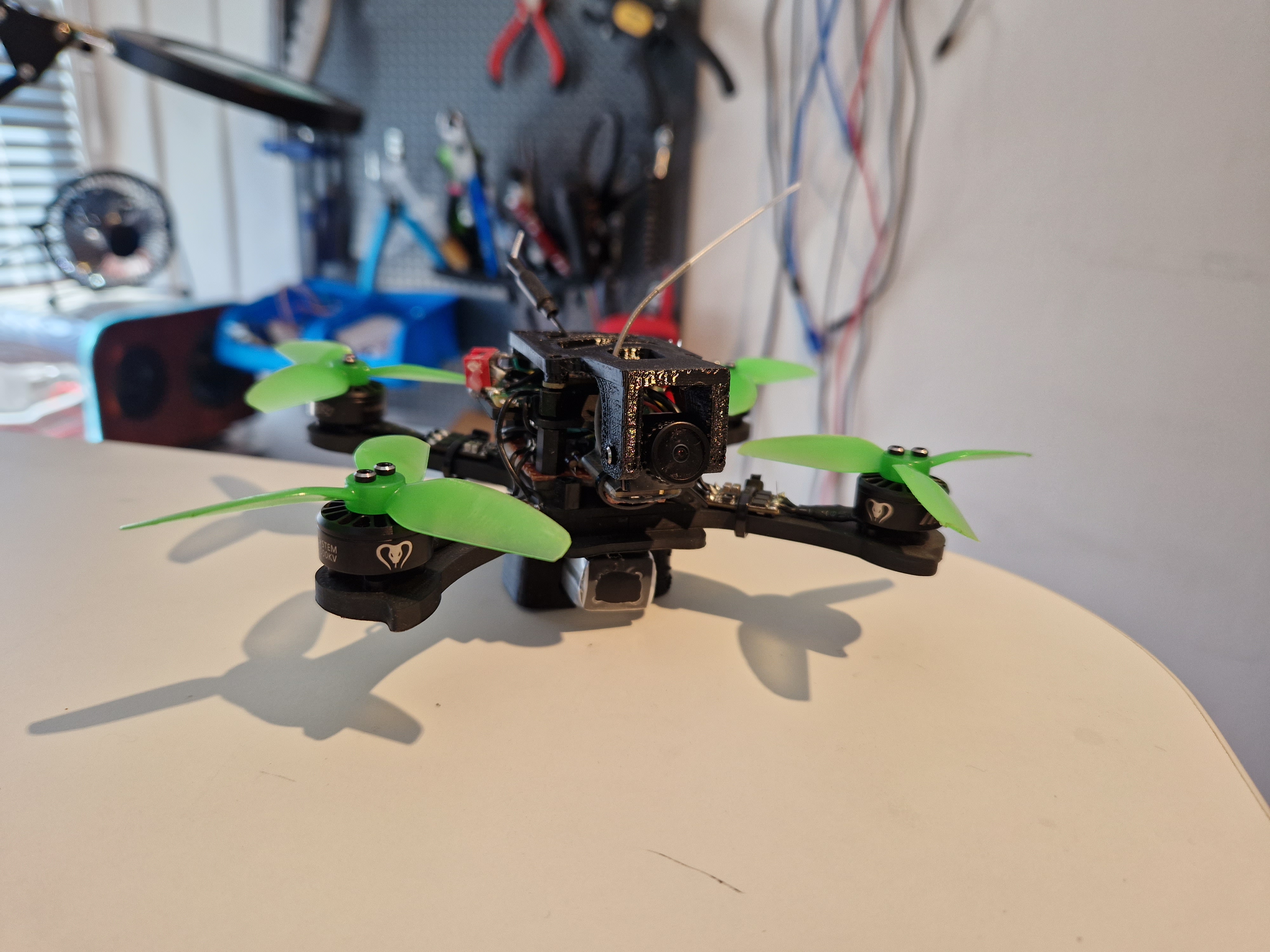A Simple And Cool Flight Controller (ASAC FC) is a flight controller based on the rp2040 microcontroller, completely open-source.
It's an incredibly cheap microcontroller that is quite powerful (up to 133 MHz), contains two cores, programmable I/O pins (PIO), seems to ignore the global silicon shortage and has an extensive C/C++ SDK.
For the second iteration of the flight controller I designed a PCB in FreeCad, ordered the pcb and components with SMD assembly for the top layer, and soldered the bottom layer myself. All cad files of this can be found in kicad/asac-fc-rev-b. Schematic can also be found at documents/asac-fc-rev-b.pdf. Some nice features of the flight controller PCB are:
- rp2040 - Flight controller (where asac runs)
- BMI270 - IMU, using SPI, which allows faster readings than the MPU-6050 which was used for iteration 1.
- USB-C - More modern, right? :)
- Individual ESC solder pads - Connection for individual ESCs. While most flight stacks today use an 4-in-1 ESC, I decided to keep it simple and use individual ESCs for now.
- Battery solder pads
The first iteration of asac fc was done with development boards, before designing a custom PCB. This is to make a proof of concept, and serves as a sanity check to show that it's possible :). The main components are:
- Raspberry pi pico - Flight controller (where asac runs)
- MPU6050 - IMU
- FS-a8s - Radio receiver (Flysky, outputs IBUS)
- xsd7a ESC - ESCs (Single motor ESCs, so 4 in total)
- Frame - Custom designed, 3D-printed in PLA.
I created a simple power distribution board (brown part, at the bottom of the drone in the picture below), where the battery is connected to. Each ESC as well as the pico and the receiver gets its power from this board. The ESCs are then connected to GPIOs on the pico.
After some manual (headless) flights, I decided to add an analog camera together with a VTX I had laying around. This way, we can fly some FPV with the pico!
- IMU
- GPS
- Barometer (altitude estimation)
- Lidar or other distance sensor
- IBUS
- SBUS
- Frsky
- CSRF
- Any
- Acro (attitude rate, aka free-style)
- Any other stabilizing mode
- PWM (50 hz)
- Oneshot125, utilizing rp2040s PIO block
- Oneshot42, utilizing rp2040s PIO block
- Multishot
- Dshot150
- Dshot300
- Dshot600
- Dshot1200
- ProShot
In order to set the correct speeds for each motor, several steps must be taken. The steps described below is how it's done for asac fc. Note that this is for acro mode only (freestyle, using only gyro rates from IMU).
- Read gyro rates from IMU
- Remove bias from gyro reading
- Filter gyro reading
- Read receiver input
- Convert receiver stick inputs to desired gyro rates. This is a mapping from eg. 1000-2000 -> -500 to 500 deg/s.
- Give the desired rates together with the measured rates to PID controller that uses PID parameters to calculate adjustment values.
- Give output from PID controller to motor mixer to get commands for each motor.
- Send the motor outputs to the ESC(s).
asac fc uses a very simple RTOS called vsrtos, that uses a priority based non-preemptive scheduling technique to run tasks. While this rtos is quite immature, it works just fine for this application, since asac fc doesn't have that many tasks yet.
The motor mixer is responsible for deciding which motor should spin and how much. asac fc uses the default motor numbers like in the image below, which is the same as the default for betaflight.
The default motor mix is:
| Motor | Throttle | Roll | Pitch | Yaw |
|---|---|---|---|---|
| 1 | 1 | -1 | 1 | -1 |
| 2 | 1 | -1 | -1 | 1 |
| 3 | 1 | 1 | 1 | 1 |
| 4 | 1 | 1 | -1 | -1 |
You can flash the pico through in three different ways:
- Through USB, when it's connected as a USB device (press down button while powering the pico)
- Through serial USB by utilizing the picotool:
picotool load -f target.uf2 && picotool reboot -fThis works if uart 0 is mapped to USB:The command above first flashes the targetpico_enable_stdio_uart(asac-fc 0) pico_enable_stdio_usb(asac-fc 1)uf2file to the pico by forcing it into BOOTSEL mode. We then reset the pico withpicotool reboot -f. The flag-fis crucial here, since it allows us to load and reboot it without being in BOOTSEL mode already. I think it accomplishes this by changing the baud rate of the connection, which forces the pico to BOOTSEL mode, but I am not 100% sure. - SWD using debugger/another pico.
There are several parameters that can be defined on build-time to configure the firmware. All of the defines can also be found in the CMakeLists.txt These includes:
| Define | Description |
|---|---|
| USE_DEFAULT_SETTINGS | If defined, asac will use default settings and write them to flash. Note that this will erase any previous settings that were stored in flash. This can be useful when using the flight controller for the first time, or updating the data structure of the flash. |
| LINUX | If defined, the firmware is built to be run on a linux machine and not for rp2040. This can be useful if you want to run unit tests on certain parts of code, or simulate fc. |
| RP2040 | Used by vsrtos. Do not change |






